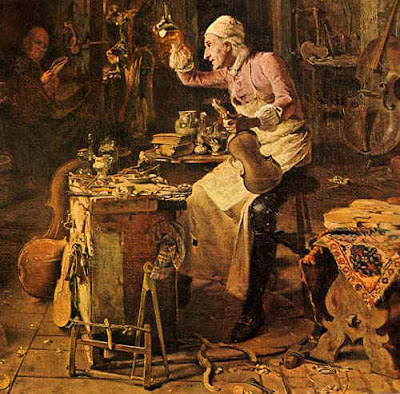Come costruirsi un tubetto di paraffina.
Se anche a voi piace lubrificare la suola delle vostre pialle e le lame delle vostre seghe, probabilmente avete sul vostro banco uno sporco pezzo di paraffina come questo.
If also you like to lubricate your planes soles and your saw plates, you probably have on your workbench a dirty piece of paraffin wax like this.
Esso non è solo brutto a vedersi, ma ha la cattiva abitudine di nascondersi quando serve per poi ricomparire a lavori ultimati.
It is not only ugly to look at, but it has the nasty habit to hide when you need it and then reappear when the work is finished.
Per ovviare a questi inconvenienti ho chiesto ai miei figli di tenermi da parte un paio di tubetti di colla vuoti.
Se avete a che fare anche voi quotidianamente con dei bambini dai 3 ai 6 anni potete ben immaginare che non ho dovuto aspettare molto per averli.
To avoid these inconveniences, I asked my children to save me a couple of empty tubes of glue stick.
If you also have to daily deal with children aged from 3 to 6 years, you can well imagine that I have not waited long to get them.

Il resto è abbastanza semplice ed intuitivo.
Li ho lavati con acqua calda, li ho lasciati asciugare, ho messo un giro di nastro adesivo intorno alla boccola filettata per chiudere bene lo spazio libero tra questa e il tubetto, ho fatto scendere del tutto la suddetta boccola, ho scaldato a bagnomaria della paraffina e poi ho riempito il tubetto fino all’orlo.
Finito.
The rest is fairly simple and intuitive.
I washed them with hot water, I let them dry, I put a turn of tape around the threaded bushing to close the space between it and the tube, I totally lowered down the before mentioned bush, I liquefy the paraffin wax using a water bath and then I completely filled the tube with the liquid paraffin wax.
Finished.
Quando la paraffina si indurisce si crea un cratere alla sommità. Se vi da fastidio potete riempirlo con altra cera.
When the wax hardens it creates a crater at the summit of the tube. If you don’t like it, you can fill it again with more liquid wax.
Se trovate che la cera di paraffina sia troppo dura, potete tagliarla con un po’ di olio di vaselina che in Italia si trova a poco prezzo dove vendono prodotti per enologia (si usa per lubrificare i tappi in sughero quando si inbottiglia il vino).
If you find that the paraffin wax is too hard, you can cut it with some mineral oil that in Italy we find, for little money, where oenology products are sold (it is used to lubricate the corks when the wine is bottled).
Attenzione che alcuni tubetti di colla hanno la vite senza fine filettata solo parzialmente.
Questi non vanno bene perchè poi quando la cera si indurisce, la vite non gira più. Forse si può risolvere questo problema facendo girare la vite quando il cuore della cera non è ancora indurito, però non ho potuto verificarlo perchè ho rotto il tubetto per vedere cosa diavolo c’era che non funzionava.
Please note that some tubes of glue stick have the worm that is only partially threaded.
These are not good for paraffin stiks because when the wax hardens, the screw does not turn. Maybe you can solve this problem by turning the screw when the heart of the wax is not yet fully hardened, but I could not test it because I broke the tube to see what the hell was that did not work.

E infine due parole riguardo a queste colle per carta.
Come molti di voi sapranno, l’Italia ed alcuni altri stati dell’europa del sud, stanno attraversando una grave crisi economico/finanziaria.
Non solo il tasso di crescita del nostro prodotto interno lordo è più vicino allo 0 che all’1 per cento, ma da qualche giorno l’affidabilità del nostro debito pubblico è stata declassata da A a BBB.
[Abbiamo anche una nave da crociera parcheggiata in divieto di sosta il cui comandante inciampando è caduto in una scialuppa di salvataggio prima di aver fatto evaquare tutti gli altri passeggeri, ma questo è un altro problema.]
E comunque questo cosa c’entra con la colla? Adesso ci arrivo.
And finally a copule of words about these paper glues.
How many of you know, in Italy and in some other countries of the south of Europe, we are going through a severe economic/financial crisis.
Not only the rate of growth of our gross domestic product is closer to 0 than to 1 percent, but some days ago the reliability of our public debt has been downgraded from A to BBB.
[We also have a cruise ship parked in a no parking zone, whose captain, stumbling, fell into a lifeboat before the evacuation of all the other passengers, but that’s another problem.]
And anyway what does this have to do with paper glues? Now I arrive there.

Se volete aiutarci, il modo migliore è acquistare qualcosa realmente prodotto in Italia e, tanto per restare in argomento, qui da noi si produce un’ottima colla per carta che ha pure un gradevole profumo.
Si chiama Coccoina e la sua formula è talmente semplice e sicura che si può persino mangiare: destrina di fecola di patate, acqua e profumo di mandorla.
If you want to help us, the best way is to buy something really produced in Italy and here we produce a good paper glue that has also a pleasant scent.
It’s called Coccoina and its formula is so simple and sure you can even eat it: dextrin of potato starch, water and scent of almond.

Viene prodotta anche in tubetto, così quando è finita potete usare il tubetto per farvi uno stick di paraffina, ma devo avvisarvi che la colla in tubetto non ha gli stessi ingredienti di quella originale, ma è a base di polivinilpirrolidone.
Che poi magari è altrettanto sicura però io sinceramente una roba con quel nome li non la mangio mica!
It is also produced in a tube stick, so when it’s finished you can use the tube to make a wax stick, but I must warn you that the glue in the stiks has not the same ingredients as the original one but is based on polyvinylpyrrolidone.
Well, maybe it is as safe as the other one, but sincerely I will not eat stuffs with that name!
Colas de milano
No, la parola milano nel titolo non ha niente a che vedere con la seconda città italiana: è semplicemente il termine spagnolo che indica il nibbio, un rapace con la coda (cola) trapezioidale.
No, the word milan in the title has nothing to do with the second Italian city: it is simply the Spanish word that means kite, a raptor with a trapezoidal tail (cola).

Julio Alonso ha scritto un post molto interessante su come fare le code di rondine a mano.
Io purtroppo non conosco lo spagnolo (che secondo me è una delle lingue più belle del mondo) abbastanza bene da comprendere tutto ciò che ha scritto, ma il bello dei suoi post è che ci mette talmente tante fotografie che ogni barriera linguistica viene facilmente superata.
Julio Alonso Diaz wrote an interesting post on how to make dovetails by hand.
Unfortunately I do not know Spanish (which I think is one of the most beautiful languages in the world) well enough to understand everything that he wrote, but the good thing of his posts is that he publish so many pictures that every language barrier is easily overcome.
Sulla stessa falsariga, qualche mese fa aveva scritto un post altrettanto interessante su come mettere a punto una pialla nuova di quelle, diciamo, non premium. 🙂
Along the same line, a few months ago he had written an equally interesting post on how to fine tune a new, let me say non-premium, plane. 🙂
Chiunque abbia un blog amatoriale, senza scopo di lucro, sa bene che ci vuole molto tempo per per scrivere un post e per sistemare le fotografie. Tempo rubato alla famiglia e/o ad altri divertimenti, quindi io mi sento di ringraziare di cuore lui e tutti gli altri che contribuiscono a divulgare la conoscenza senza pretendere nulla in cambio se non, a volte, un semplice grazie.
Grazie Julio Alonso, grazie bloggers e grazie forumisti.
Anyone who own an amateur, non-profit, blog, knows that it takes a long time to write a post and to arrange the photographs. Time stolen from the family and/or other entertainments, so I feel to thank him and all others who help to disseminate knowledge without expecting anything in return except, sometimes, a simple thank you.
Thank you Julio Alonso, thank you bloggers and thank you forum user.
Affilatura delle seghe giapponesi

Avevo sempre pensato che le uniche informazioni e istruzioni sull’affilatura delle seghe giapponesi fossero nel libro di Toshio Odate (Japanese Woodworking Tools Their Tradition, Spirit and Use, dalla pagina 51 alla 54), ma ieri ho scoperto che anche Wilbur Pan ha scritto alcuni articoli sull’argomento molto interessanti e demistificatori.
Eccoli:
I had always thought that the only informations and instructions about japanese saws sharpening were in Toshio Odate book (Japanese Woodworking Tools Their Tradition, Spirit and Use, pages 51 to 54), but yesterday I discovered that also Wilbur Pan wrote some very interesting and demistifing articles about this subject.
Here they are:
Alcuni utensili di Antonio Stradivari
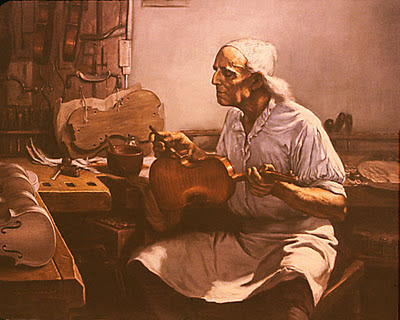
Gran parte del materiale esistente nella bottega di Antonio Stradivari, alla sua chiusura, cioè alla morte del figlio Francesco (1743), venne venduto da Paolo Stradivari al conte Ignazio Cozio di Salabue, il quale lo acquistò perché il liutaio G. B. Guadagnini potesse costruire violini simili a quelli del Maestro.
A lot of the existing material in the workshop of Antonio Stradivari, at its closure, that was at the death of his son Francesco (1743), was sold by Paolo Stradivari to the count Ignazio Cozio di Salabue, who bought it because the violin maker G. B. Guadagnini could make violins similar to those of the master Stradivari.
Questa collezione di forme, modelli, disegni e utensili, passata per eredità ai marchesi torinesi Dalla Valle del Pomoro, fu nuovamente venduta nel 1920 al liutaio romano Giuseppe Fiorini, il quale, per battere un concorrente, dovette indebitarsi per una somma ingente, ma dieci anni dopo (1930) donò la collezione alla città di Cremona, con l’obbligo che fosse pubblicamente esposta.
This collection of forms, models, designs and tools, passed by inheritance to the turin marquis Dalla Valle del Pomoro, was again sold in 1920 to roman luthier Giuseppe Fiorini, who, to beat a competitor, had to borrow a large sum, but ten years later (1930) he donated the collection to the city of Cremona, with the obligation that it was publicly exposed.

Questi cimeli erano esposti, il mese scorso, al museo civico di Cremona.
These relics were exhibited, last month, at the Civic Museum of Cremona.

Io ci sono andato sopratutto per vedere gli utensili, che per la verità non erano molti e sicuramente ne mancavano alcuni, come per esempio le seghe, le pialle da banco e le sgorbie larghe.
I went there mainly to see the tools, which in truth were not many and certainly some were missing, such as saws, bench planes and large gouges.
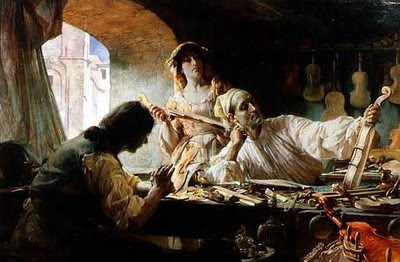 Ho scattato qualche foto, ma purtroppo non sono molto chiare, perchè i pezzi erano sotto vetro, l’illuminazione era scarsa e non si poteva usare il flash.
Ho scattato qualche foto, ma purtroppo non sono molto chiare, perchè i pezzi erano sotto vetro, l’illuminazione era scarsa e non si poteva usare il flash.I took some pictures, but unfortunately them are not very clear, because the tools were under the glass, the lighting was poor and I could not use the flash.
 Comunque, se qualcuno è interessato a qualche foto alla massima risoluzione, potete liberamente chiedermele nei commenti o per email.
Comunque, se qualcuno è interessato a qualche foto alla massima risoluzione, potete liberamente chiedermele nei commenti o per email.However, if someone is interested in some photos at full resolution, feel free to ask me, in the comments or by email.


Sopra potete vedere un compasso/graffietto e un trapano a corda e molla per forare i piroli.
Above you can see a marking gage compass and a rope and spring drill to bore the pegs.
 Alcuni scalpelli, un alesatore per i fori dei piroli, dei succhielli di varia misura e due graffietti regolabili.
Alcuni scalpelli, un alesatore per i fori dei piroli, dei succhielli di varia misura e due graffietti regolabili.
Some chisel, a reamer for pegs holes, some various sizes gimlets and two adjustable scratchers.
A lathe for the pegs driven by a bow and several pulleys
Some gouges and some compass feeler gauges.
 Una raspa a coda di ratto, una lima tonda, due piccole squadre, diverse rasiere e altri utensili non identificati.
Una raspa a coda di ratto, una lima tonda, due piccole squadre, diverse rasiere e altri utensili non identificati.Da notare che le rasiere non sono affilate come facciamo noi oggi, ma sono affilate a coltello.
A rat tail rasp, a round file, two small squares, several scrapers and some other unidentified tools.
Note that the scrapers are not sharpened as we do today, but they are sharpened like knives.
Le due squadre autocostruite.
Quella più in masso me la costruirò anch’io prossimamente.
The two shopmade squares.
I’ll also self build the one below in the near future.
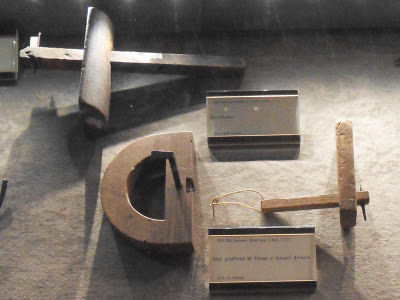 Due truschini o graffietti e una granny tooth router plane. Confesso la mia ignoranza, ma di quest’ultima pialla non conosco il relativo termine in italiano. Se qualcuno volesse essere così gentile da venirmi in aiuto, gliene sarei davvero grato.
Due truschini o graffietti e una granny tooth router plane. Confesso la mia ignoranza, ma di quest’ultima pialla non conosco il relativo termine in italiano. Se qualcuno volesse essere così gentile da venirmi in aiuto, gliene sarei davvero grato.Da notare che nei due truschini non c’è nessun meccanismo per bloccare le aste sulle battute.
Two marking gauge and a granny tooth router plane.
Note that in the two marking gauges, there are no mechanism to secure the beam to the stock.
One of the two marking/cutting gauges described above.
The othe one.
Three feeler gauges.
Three othe feeler gauges and some convex sole small and finger planes.
The planes in detail.
The planes again.
Una pietra molto piccola per affilare sgorbie e altri utensili.
A very small sharpening slip stone for gauges and othe tools.
Il mio primo pensiero uscendo dal museo è stato che, diversamente da oggi dove noi compriamo costosi utensili premium, fatti con materiali innovativi e con regolazioni micrometriche, un tempo, i nostri predecessori riuscivano a costruire capolavori anche con pochi e poveri strumenti.
Siamo progrediti o regrediti?
Siamo progrediti o regrediti?
My first thought exiting from the museum was that, unlike today where we buy expensive premium tools, made with innovative materials and precision adjustment, once, our ancestors were able to build masterpieces with few poor tools.
We progressed or regressed?
Questo articolo di Daniela Ranieri sull’impazzimento generale per la morte di Steve Jobs non riguarda gli utensili o la lavorazione del legno, ma è talmente geniale che non riesco a non rilanciarlo.
This article wrote by Daniela Ranieri about the general madness for the death of Steve Jobs does not concern with tools or woodworking, but it’s so brilliant that I’m not able to not relaunch it
I will not translate it in English because I suspect that only Italians and maybe Germans have the necessary knowledge in order to understand it, sorry.
Il primo folletto lo comprai nel ‘99. Ricordo che nel mio condominio mi guardarono tutti come se fossi pazza. «Ecco quella della scopa elettrica», dicevano quando arrivavo, ma a ma non importava, perché era vero. Ero un outsider, una ribelle, una che aveva lasciato la polverosa via vecchia per la nuova. Quella doppia W inserita in un vortice mi aveva cambiato la vita, e presto l’avrebbe cambiata a tutto il mondo, divenendo il simbolo di chi non si arrende, di chi lotta per le proprie idee, ed è affamato di esperienza e di novità.Egelbert Gorissen non c’è più. Lui, genio visionario, che per primo nella azienda chr aveva fondato e da cui si era distaccato a 31 anni per l’acre conflitto che lo contrapponeva alla anacronistica proprietà, se n’è andato, lasciandoci tutti un po’ più soli. È inutile, ora, cadere nel sentimentalismo, lasciarsi andare ai ricordi di quanto la sua personalità abbia rivoluzionato gli stili di vita e di pensiero di milioni di persone. Basti ricordare le sue imprese, che basate su un’idea semplice come semplici sono le idee geniali, hanno fatto della sua figura l’icona e il modello di una generazione. L’oggetto che tutti oggi abbiamo in casa non è solo utile: è poetico. Non serve “solo” per pulire, ma racchiude nel suo cuore la magia delle arti: Egelbert Gorissen, chiuso nel suo garage insieme al compagno di università Adolf Vorwerk, ha avuto, unico al mondo, l’idea di piazzare delle minuscole manovelle nel motore di un grammofono per farne il cuore di una scopa elettrica.Vedendola in azione, maneggevole, agile, veloce, portatile, la sua segretaria esclamò entusiasta: «ma è un piccolo Kobold!» (in tedesco appunto “folletto”). Da allora quel miracoloso portento è entrato nelle vite di tutti noi, a tutte le ore della giornata, ovunque. Egelbert, è vero, è diventato miliardario, e ha fatto arricchite quelli che hanno avuto la fortuna di collaborare con lui d condividerne la sorte umana e professionale. Ma lui non badava ai soldi: negli ultimi anni della malattia ha rinunciato allo stipendio e si accontentava di un simbolico pfenning all’anno, conscio che il vero guadagno era la destinazione della sua creatura. Grazie a lui milioni di individui e di masse povere hanno trovato lavoro, come ingegneri o come semplici domestici; grazie a lui e al suo genio visionario il mondo si è riscattato.Il suo motto, siate aspiranti, siate elettrici, è la guida che vogliamo per i nostri giovani, che infatti lo hanno fatto proprio.Ora, siamo sicuri, questo piccolo grande mago del folletto, è al cospetto di Dio, a cui si sia presentato col suo geniale candore e insieme con la certezza di avere reso il suo mondo, il mondo della Bibbia, più nuovo e pulito. Ora è lui a spicciare la casa più grande, il Paradiso.Grazie Egelbert, non ti dimenticheremo mai.
Come viene costruita una pialla da banco Clifton
Da qualche settimana, anche in Italia è possibile vedere Come è Fatto, una serie di brevi documentari televisivi prodotti da Discovery Channel che mostrano il processo produttivo di molti oggetti di uso quotidiano (o quasi).
Since few weeks, also in Italy you can see How It’s Made, a series of short television documentaries produced by Discovery Channel that show the manufacturing process of many everyday objects (or almost).

Qui in Italia va in onda su Real Time (canale 31), dal lunedì al venerdi, intorno a mezzogiorno ed è condotto da Barbara Gulienetti quella simpatica ragazza che fa cose oscene nel programma Paint Your Life.
Scusami Barbara, il tuo programma è molto interessante e godibilissimo ma certe cose che fai sono semplicemente inguardabili. 🙂
Here in Italy it is aired on Real Time (channel 31), from Monday to Friday, around noon and is led by Barbara Gulienetti that nice girl who does obscene things in Paint Your Life show.
Barbara I’m sorry, your program is very interesting and enjoyable but some things you make are simply unwatchable. 🙂
In attesa di vedere, anche in italiano, il video che mostra la produzione delle pialle Clifton, eccovi la versione originale in inglese:
Waiting to see, in Italian too, the video that shows the manufacturing of Clifton planes, here’s the original English version:
Fonte (source): UK Workshop Forum
Si sente poco parlare delle pialle inglesi Clifton principalmente perchè la Clico (Sheffield) Tooling Ltd. non investe nemmeno un centesimo in marketing e pubblicità, al contrario di Lie Nielsen e Veritas, basti pensare che non hanno nemmeno un sito web, ma sono comunque delle pialle fantastiche.
Spessore del corpo maggiore del consueto, lama in acciaio al carbonio (RC 60-62) spessa 3 mm, controferro Stay-Set, sistema di regolazione del frog di tipo Bedrock, manici in Bubinga, inserti in ottone e un attenta cura per ogni dettaglio.
Io ho avuto la possibilità di avere per le mani una no. 5-1/2 e vi assicuro che è una vera bestia.
L’unico difetto, se proprio devo trovargliene uno, è che l’impugnatura posteriore è un pò troppo verticale per i miei gusti, come nelle Veritas.
There is a little talk about Clifton british planes mainly because the Clico (Sheffield) Tooling Ltd. does not invest a penny in marketing and advertising, as opposed to Lie Nielsen and Veritas, just think that they does not even have a website, but them are fantastic planes.
Thickness of the body more than usual, 3 mm thick carbon steel blade (RC 60-62), Stay-Set chipbreaker, Bedrock type frog adjustment system, Bubinga handles, brass inserts, and a careful attention to every detail.
I had the opportunity to have in the hands a no. 5-1/2 and I assure you that it is a real beast.
The only defect, if I have to find one, is that the rear handle is a bit too much vertical for my taste, as in Veritas ones.

Un altro grave difetto è che costano un botto e sono totalmente al di fuori della portata del mio portafoglio. 🙂
Another major defect is that they cost a bang and are they are completely outside the range of my pocket. 🙂
In ogni caso, questi sono alcuni web-store dove potete trovare ulteriori informazioni riguardo queste pialle:
In any case, these are some web-store where you can find more information about these planes:
Una recensione anarchica di The Anarchist Tool Chest
Have you already read the MaFe not so good review about the latest Christopher Schwarz book?
Avete già letto la recensione non tanto buona di Mafe sull’ultimo libro di Christopher Schwarz?
Many have found it irreverent.
Some have found it outrageous.
Few have found it blasphemous.
I’ve found it funny. 🙂
Molti l’han trovata irriverente.
Alcuni l’han trovata oltraggiosa.
Pochi l’han trovata blasfema.
Io l’ho trovata divertente. 🙂
Despite his negative review, I will buy the book, when I’ll find a used copy, now it costs too much for my pockets, because I’m really curious to see Christopher Schwarz workshop wooden floor.
🙂
Nonostante la sua critica negativa, io comprerò il libro quando lo troverò usato, ora costa troppo per le mie tasche, perchè sono veramente curioso di vedere il parquet del laboratorio di Christopher Schwarz. 🙂
But MaFe is not only this.
Take a look at his blog and you will find a lot of interesting projects such as this low angle shoulder plane;
Ma MaFe non è solo questo.
Date un occhiata al suo blog e troverete un sacco di progetti interessanti come questa sponderuola ad angolo basso;

this small router plane;
questa piccola router plane;
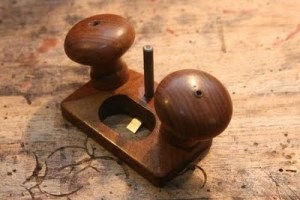
this chisel plane and
questa pialla-scalpello e

questa guida per affilare e brunire le rasiere. Stavo scrivendo: le scarpiere. 🙂

I feel I have a special affinity with him, not only because we share the same age, but also because we both have a daughter with the same name and who likes woodworking.
His ten years old daughter made this little bed for her cousins dools and
Io sento di avere una particolare affinità con lui, non solo perchè condividiamo la stessa età, ma anche perchè entrambi abbiamo una figlia con lo stesso nome e a cui piace lavorare col legno.
Sua figlia di dieci anni ha fatto questo piccolo letto per le bambole delle sue cugine e

my four and half one made this bench for when her doll come back tired from a mountain walk. 🙂
mia figlia di 4 anni e mezzo ha fatto questa panchina per quando la sua bambola torna stanca da una camminata in montagna. 🙂

Ignore this post.
Mi serve solo come base su cui caricare le foto per questo thread sul forum Legnofilia:
I just need it as a basis where to upload some photos for this thread on the italian forum Legnofilia:


Questa è una tipica rottura che si riscontra frequentemente sulle vecchie seghe: il corno posteriore superiore.
This is a typical fracture that is frequently found on old saws: the back top horn.
Il procedimento più comunemente usato per riparare queste rotture è il seguente:
1 – tagliare via una fetta della parte superiore cercando il più possibile di segare parallelamente alla venatura;
2 – incollarci un nuovo blocchetto di legno, della stessa essenza e con lo stesso verso della venatura del resto del manico, di dimensioni abbondanti;
3 – sagomare il nuovo blocchetto seguendo il disegno di un’altra sega o prolungando ad occhio le curve esistenti;
4 – carteggiare finemente e mordenzare cercando di copiare il colore della patina del resto della sega.
Qui potete trovare un paio di esempi di questo tipo di riparazioni:
The most commonly used procedure to repair these breaks is the following:
1 – cut off a slice of the top horn trying to saw as possible parallel with the grain;
2 – glue a new piece of wood, of the same species and with the same grain direction as the rest of the handle, generous in size;
3 – shape the new piece following the design of another saw or extending the existing curves by eyes;
4 – sand finely and stain trying to copy the color of the patina of the rest of the handle.
Here you can find a couple of examples of this type of repair:
Questo metodo, oltre ad essere il più semplice e veloce, è anche quello più adatto per mantenere il valore storico ed economico delle seghe antiche e preziose.
This method, besides being the fastest and easiest, is also the one most suitable to maintain the historic and economic value of antique and precious saws.
Ma io non possiedo seghe antiche e preziose, solo vecchie ed usate e mi piace che le mie riparazioni siano ben visibili, quindi cerco di sbizzarrirmi con soluzioni inconsuete.
Le foto parlano da sole, ma ecco comunque qualche ragguaglio.
Ho tagliato verticalmente tutto il corno.
Ho preparato una piccola mezza coda di rondine su un pezzo di faggio chiaro.
Ho trasferito il disegno della coda sul manico e ho scavato la mortasa.
But I don’t own antique and precious saws, just old and used ones and I like that my repairs are clearly visible, so I try to have fun with unusual solutions.
The pictures speak for themselves, but here are some information anyway.
I cut the horn vertically .
I prepared a small half tail on a piece of light beech.
I transferred the tail on the handle and I made the mortise.
Dopo alcune prove a secco e qualche aggiustamento ho incollato il nuovo pezzo di faggio e vi ho disegnato sopra le linee di taglio, prolungando a occhio le curve esistenti.
After several dry attempts and some adjustments I glued the new piece of beech and I have drawn on the cut lines, extending the existing curves by eye.
Ho messo del nastro da mascheratura per evitare di rovinare il manico nel malaugurato caso che un utensile mi scivolasse (come è puntualmente accaduto).
Ho tagliato via l’eccedenza con un seghetto a copiare.
I put on some masking tape to avoid damaging the handle in the unlikely event that a tool slip (as it duly happened).
I cut off the excess with a coping saw.
E ho sagomato la parte restante con scalpelli, sgorbie, raspe e carta vetrata, facendo molta attenzione alla zona di transizione tra il legno nuovo e quello vecchio, perchè volevo evitare il più possibile di rimuovere la patina di quest’ultimo.
Per la finitura ho usato un mix di olio di lino crudo e cotto, essenza di trementina, cera d’api e carnauba.
And I shaped the rest with chisels, gouges, rasps and sandpaper, paying close attention to the transition zone between the new and old wood, because I wanted to avoid as much as possible to remove the patina of this last one.
To finish I used a mix of boiled and raw linseed oil, turpentine, beeswax and carnauba wax.
Come potete vedere non è la prima volta che faccio delle riparazioni, diciamo, stravaganti. 🙂
As you can see this is not the first time I do this kind of, let me say, extravagant repairs. 🙂
Extended Y-levers to fit thicker blades.
Uno dei problemi per poter montare una lama più spessa su una pialla vintage è che la leva a Y (7) potrebbe non ingaggiare correttamente la feritoia del controferro.
One of the problems in order to install a thicker blade on a vintage plane, is that the Y-lever (7) may not properly engage the chipbreaker slot.
Oggi, grazie a Michele, ho scoperto che Workshop Heaven vende le leve a Y, opportunamente allungate, per poter montare le lame Qiangsheng (Matthew le chiama Quangsheng) sulle pialle Stanley, Record e Clifton.
Today, thanks to Michele, I discovered that Workshop Heaven sells Y-levers, properly extended, in order to mount Qiangsheng (Matthew calls them Quangsheng) blades on Stanley, Record and Clifton planes.
Peccato che non ci siano le foto.
Matthew, mi faresti una foto delle 3 leve a Y, una vicino all’altra, che la pubblico sul blog?
Unfortunately, there are no photos.
Matthew, could you take a picture of the 3 Y-levers, side by side, so that I will publish it on the blog?





